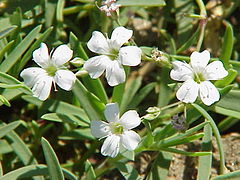Gypsophila repens
| Gypsophila repens subsp. var. | ||||||||||||||||||||||||||||||||||||||||||||||||||||||||
|---|---|---|---|---|---|---|---|---|---|---|---|---|---|---|---|---|---|---|---|---|---|---|---|---|---|---|---|---|---|---|---|---|---|---|---|---|---|---|---|---|---|---|---|---|---|---|---|---|---|---|---|---|---|---|---|---|

|
|
| ||||||||||||||||||||||||||||||||||||||||||||||||||||||
| ||||||||||||||||||||||||||||||||||||||||||||||||||||||||
Gypsophila repens is a perennial plant of the genus Gypsophila. It can grow around 20 cm (8 in) tall and has white, lilac or light purple flowers.[1]
| Standard Cyclopedia of Horticulture |
|---|
|
Gypsophila repens, Linn. (G. pros- trcUa, Hort., not of Linn.). Sts. trailing or prostrate, ascending at the ends, not glaucous: lvs. linear, sharp- pointed, glabrous: fls. rather large, white, the petals about twice longer than the sepals and the pedicels usually much longer. Alps and Pyrenees.—Best adapted to the rockery, and the mixed border; blooms from midsummer to autumn. Var. monstrosa, Hort., is larger but otherwise the same. Var. rosea, Hort., has rose-colored fls. and is frequently sold as G. prostrala rosea, also as G. carminea, Hort., which does not seem to differ.
|
Cultivation
Propagation
Pests and diseases
Varieties
Gallery
-
photo 1
-
photo 2
-
photo 3
References
- ↑ "Botanica. The Illustrated AZ of over 10000 garden plants and how to cultivate them", p. 419. Könemann, 2004. ISBN 3-8331-1253-0
External links
- w:Gypsophila repens. Some of the material on this page may be from Wikipedia, under the Creative Commons license.
- Gypsophila repens QR Code (Size 50, 100, 200, 500)

